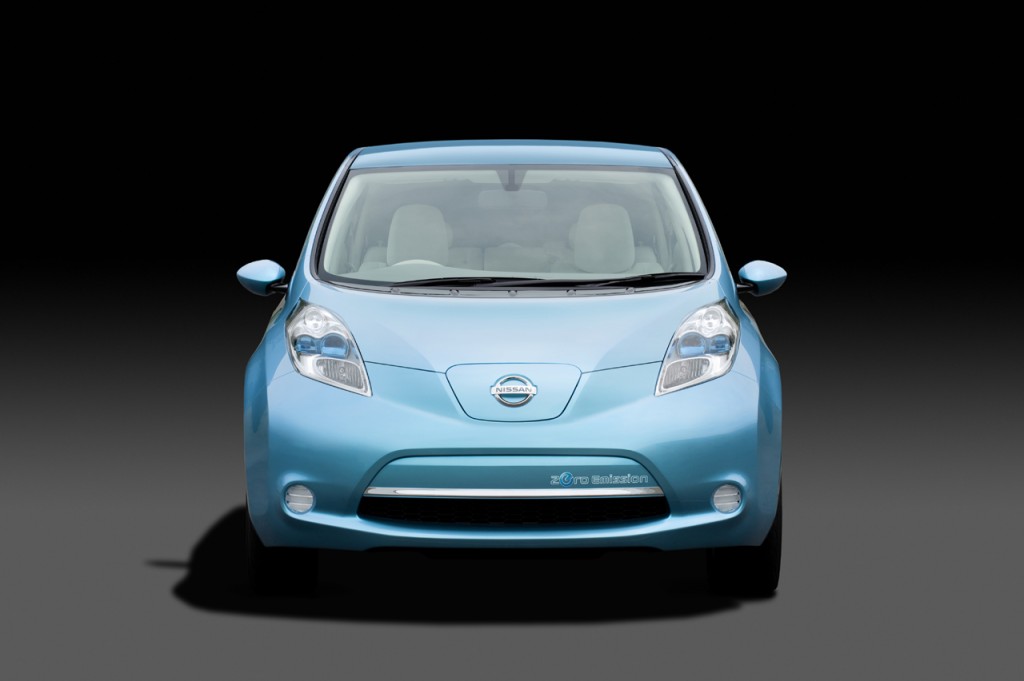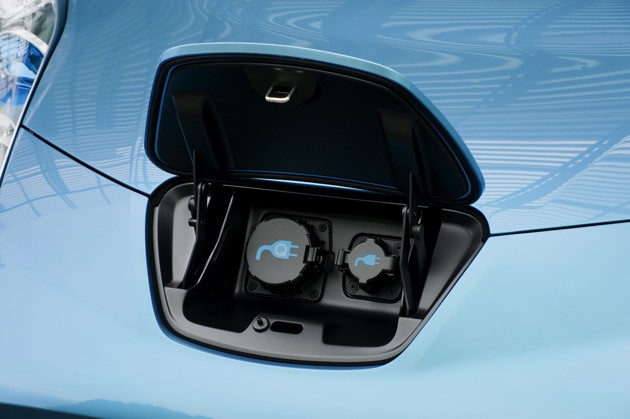I am very happy to see another electric vehicle on the near horizon: the Nissan Leaf was announced on August 2nd. There’s a very comprehensive post on AutoBlogGreen, including a video.
They appear to have done a lot of careful design: they did as much aerodynamic design as they could without having obvious things like wheel skirts. They did not want it to look like a Prius/Insight, and though it has the same basic shape of those cars, it obviously looks more “normal” than they do. Personally, I would prefer a lower window sill line — which would improve rearward visibility. And I hope that it can be had with steel wheels, so one can use smooth wheel covers.
I want it to work well; and as long as it avoids any “stupid” styling (which I think it does!) that hurt how it works, then I’m happy. Form should follow function, like with the Aptera. Styling should be limited to the “graphic” adjustments of the aerodynamic shape. Again, the best example of this is comparing the earlier Aptera MK-0 and Typ-1 to the current model. They changed the height, and they changed the “graphics” of things like the shape of the windows and the headlights, and while the overall shape is the same slippery form, the newer models look much better.
To quote the ABG article on this subject:
A Question of Style
Interestingly, unlike the current alt-fuel darlings from Toyota and Honda, Nissan has purposefully eschewed a fastback shape for a more formal five-door appearance. Shiro Nakamura, Nissan’s senior vice president and chief creative officer (read: styling director) admits he wanted the car to be unique, but not so bizarre as to be off-putting to most car buyers:
“From the beginning, we did not want to make the car very strange, because one of the perceptions of the EV [is that] people think that EVs are toys, or cheap… that you cannot drive high-speed, that EV means ‘not real car.’ But the car we have is a real car – you can drive it at 140 kilometers, you can sit four or five passengers comfortably.
By that measure, the more upright yet unique Leaf is a success – it is a slippery shape with real passenger space, yet it doesn’t resort to visually polarizing aerodynamic tricks like faired-in wheel housings and to maximize aero. Instead, it has a smooth face (secreting two charging ports hiding beneath the Nissan logo), strangely prominent blue-tinted headlamps that manage airflow as much as they do nighttime vision, and a roofline whose rearmost pillar reminds us of another Nissan – the Murano. The Leaf has an almost Gallic rump that recalls that of the Versa, a design that in turn reminds us of offerings from Nissan’s European partner, Renault.
From what we have been told so far, the Leaf will have range of 100 miles, carrying four adults or five people, and it has two charging plugs: a 120v and a 240v (~16 hours and ~8 hours for a full charge, respectively) — and there is the ability to use a 3-phase fast charge (if you have access to an expensive special charger) that does an 80% charge in less than 30 minutes, or an ~30% charge in about 10 minutes. The battery pack is ~200kg (440 pounds) and is made up of 48 laptop-sized modules (each of which has 4 magazine-sized cells). These are thin, laminated lithium ion cells (that may be similar to the battery used in the newest MacBook Pro laptops) — and they are installed in the floor of the Leaf. The total weight of the car is probably similar to say the Versa, but the Cg is probably much lower because of where the batteries are installed.
So, the (non-exhaustive) list of EV’s that we already have seen, or will be seeing in the next few years grows a bit longer:
- Nissan Leaf
- Toyota/Scion FT-EV
- Mitsubishi iMiEV
- Aptera 2e
- Coda Automotive
- Ford Focus EV
- Mini E
- Th!nk City
- BYD F3DM
Popularity: 19% [?]






{ 6 comments }
The Leaf goes a bit over 3km/kwh which would cost me $0.12 or 4 cents per km. using Ontario city rates. There comparison goes 20km/l or $1.00’s worth of gas. That’s 5 cents per km.
In Germany last month gas was about $2/l but electricity is about $0.35/kwh. so there is no saving at all. Their math may work in Japan with expensive gas and cheap electricity, less than 4 cents/hr. but it won’t hold up for much of the world.
Then the battery pack needs replacement $10,000 or the car scrapped in as little as 6 years.
As for Greenness, much N. American power comes from burning dirty coal and dirty gas so the improved enviornmental effects will realy be minimal.
I’m not against it, just pointing out a few things that need to be considered.
PS
My Segway goes 20km for lesst han 10 cents and my electric bike even better if I peddle some.
Hello Mike,
It’s not just about cost — it is about transitioning to alternative energy sources, and electricity is by far the most flexible in this regard. Petroleum is heavily subsidized and so the real cost is much higher (think sweetheart leasing deals and fighting wars over oil, for starters!). Another thing to add in is the maintenance cost of running an ICE — oil changes etc. add up. With an EV, you only really have tires and brakes for regular maintenance.
I’m also a little surprised at your numbers — the Aptera travels 100-120 miles on a charge, and depending on the cost of electricity, that is typically $1 (though here in NE it might be as high as $2) — so that is $0.01-0.02 per MILE. The Aptera 2e battery pack is 17-23kWh (we do not know precisely, yet), and the Leaf has a 28kWh battery, so even if we call it $3 a charge, that costs just $0.03/MILE; or $0.0186/km.
I think you are being too pessimistic on the battery replacement — some Prius batteries have gone 400-500K miles, and since most EV’s are quite conservative in their charge and discharge levels, there is a pretty good chance that the batteries will last as long as the vehicle. The materials from the battery can and will be recycled.
Since electric motors are so efficient (92-95% is what I have often heard!) it makes even coal generated electricity produce less carbon than burning fossil fuel. Yes, certainly we need to start to get more and more of our power from renewable sources — but we can also conserve way more power than we can use up with EV’s any time soon. California uses ~50% as much electricity per person than the rest of the country, so if we all can start to conserve even close to that, then we are going to be getting our transportation “for free”.
I stand corrected on the cost per charge, as I understood the batteries to be 50kwh. and not 28kwh. That brings it down to just over 2 cents CDN at Ontario city rates, or less than 1/2 the cost of a compariable gas vehicle.
The Leaf seems to have a lot going for it such as range, comfort, dual voltage charging ( I already have 220v in my gararge for a welder) and conservative styling. Most of my driving is less than 120km/day and Toronto is implamenting charging stations with new government funding to encourage EVs.
Interesting that many of our northern communities have had parking with 15A 110v recepticles for many years that are used for block heaters in the winter months.
Acceleration and top speed are a bit excessive for Ontario, as we have a $10,000 racing fine for 50km over the limit. Hopefully the car has seat belts, air bags and the other safety requirements for Canadian roads.
It will be interesting to see how the batteries preform in cold weather as much of our country has periods of -10C to -30C each winter. The car would also lose range for the heater and defrost system.
A modern gigawat coal plant ( Schwartzapumpe E. Germany) burns about 2 million kg. of coal per hour or 2kg of coal per kw. so if the Leaf goes about 6km. per kw. you are burnig a kg of coal for every 3 km. or releasing over 3 kg. of CO2 . Thats about 1 kg CO2 per km. The gas equilivant burns 1 l. in 20 km. Assuming the gas is all carbon and weighs 1kg it releases about 3kg of CO2 in 20 km or 150g per km. Sort of makes a Hummer look good.
These are only ball park numbers, and I hope there is an error in them, as I only just did the calculations, but it seems that burning a fossel fuel in a power plant, converting it to steam and then electricity, transforming it several times during transportation and then charging batteries to power an automobile just isn’t very efficient.
No I’m not on the payroll of any energy company, it’s just the laws of thermodynamics.
Maybe we should go back to steam cars. I think the Stanley Steamer, circa 1920’s, did better than 1km/kg. coal.
EV’s only become green with power from renewable sources and this is harder to implament in N. America due to the political influence of Oil, Coal and Nuclear concerns.
I took these numbers from a Physics handbook and they came out rather close to the Greman power plant. Various types of coal have different BTU values and thus will release varing amounts of CO2 per ton. I couldn’t find a BTU rate for pure carbon so I used the rate of a top grade US coal and assumed it to be nearly pure carbon.
Approximarion of CO2 released from a coal fired generating plant.
Coal top grade about 14,000 BTU/lb.
1w. = 3.413BTU
1kw – 3413 BTU
Coal fired generating plants run at about 30% efficiency.
1 lb coal gives 1.3kw
1 kwhr – .8 lb or 363 gm. of coal
12 units of coal burnt release 44 units of CO2 (C=12 O=16)
1 kwhr = 2.93 lb or 1.33kg of CO2.
CO2 released from mining, processing, and transportation, not included.
Transforming and transporting the electricity also involves losses, so much so that the actual current stored in a lead battery could represent 50% or less of the power generated, or twice the CO2 pollution given above.
I understand that the Leaf has a 28kWh battery, but doe sit take 28kWh to charge it or is there waist in the charging process. The true power usage would be determined by what it takes to charge it not what it actually uses from the battery.
Just curious
Hi Jeff,
Two points: the 28kWh is the total capacity of the battery, but they not use all of it (same as any EV battery), because if they did, the life of the battery would be greatly reduced. I do not know exactly how Nissan designed theirs, but typically, they charge it up to ~80% and discharge it down to ~20%, so the actual yield is ~16.8kWh.
Second point is that there is some loss in the charger, and again I do not know the specifics. So, it might take 18-20kWh to charge it?
Sincerely, Neil
Comments on this entry are closed.